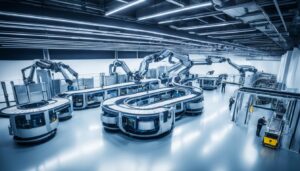
The Internet of Things (IoT) has transformed the way we interact with our environment by interconnecting devices, machines, and sensors to the Internet. This revolutionary technology enables the collection and exchange of data, paving the way for a more connected and intelligent world.
IoT technology encompasses four primary systems that work together to enable its functionality and capabilities. These systems are:
Sensing and Perception
The Sensing and Perception system acts as the senses of IoT devices, allowing them to collect data from the physical world. It involves the use of sensors that capture data from the environment, such as GPS, X-rays, radars, and cameras.
Communication and Connectivity
The Communication and Connectivity system is responsible for transmitting the collected data to the cloud or designated processing systems. It utilizes connectivity platforms such as Wi-Fi, Bluetooth, and cellular networks to ensure seamless data transfer.
Data Processing and Analytics
The Data Processing and Analytics system is the brain of the IoT architecture. It involves analyzing the collected data and transforming it into actionable insights. Data processing allows for effective utilization, while analytics enhance the functionality of IoT by providing valuable insights.
Actuation and Control
The Actuation and Control system enables the remote control and manipulation of physical devices based on the insights derived from data analysis. It facilitates automation and efficient utilization of connected devices in various applications and industries.
These four primary systems of IoT technology – Sensing and Perception, Communication and Connectivity, Data Processing and Analytics, and Actuation and Control – form the foundation of IoT, enabling its transformative capabilities.
Key Takeaways:
- The four primary systems of IoT technology are Sensing and Perception, Communication and Connectivity, Data Processing and Analytics, and Actuation and Control.
- Sensing and Perception enables the collection of data from the physical world using various sensors.
- Communication and Connectivity ensures seamless data transmission using platforms like Wi-Fi, Bluetooth, and cellular networks.
- Data Processing and Analytics analyzes the collected data and transforms it into valuable insights.
- Actuation and Control allows for remote control and manipulation of physical devices based on data analysis.
Sensing and Perception System
The Sensing and Perception system plays a vital role in the Internet of Things (IoT) ecosystem by acting as the senses of IoT devices. This system enables IoT devices to collect valuable data from the physical world, providing insights and facilitating efficient decision-making processes.
At the heart of the Sensing and Perception system are sensors, which are devices designed to capture data from the environment. These sensors are essential components of IoT devices as they convert non-electrical inputs into electrical signals, making them compatible with digital processing systems.
The role of sensors in IoT is crucial as they enable the translation of real-world events and phenomena into actionable data. They enable devices to perceive and interpret the physical world, opening up a range of opportunities for applications in various industries, such as healthcare, transportation, agriculture, and manufacturing.
There are different types of sensors used in IoT, each with its own specific capabilities and applications. Some commonly used sensors in IoT include:
- GPS sensors: these sensors utilize satellite signals to determine precise location data, enabling accurate geolocation and tracking.
- X-ray sensors: these sensors are used in medical applications and industrial inspection to capture detailed images of objects and structures.
- Radar sensors: these sensors use radio waves to detect and measure the position, speed, and direction of objects, making them suitable for applications such as traffic monitoring and object detection.
- Camera sensors: these sensors capture visual data, enabling image and video analysis for applications like surveillance, facial recognition, and object detection.
Sensors in IoT are constantly evolving, with advancements in technology driving the development of more sophisticated and specialized sensors. This evolution contributes to the continued growth and expansion of the IoT ecosystem, unlocking new possibilities for smart and connected solutions.
Communication and Connectivity System
The Communication and Connectivity system is a critical component of the Internet of Things (IoT), facilitating the seamless transfer of data collected by sensors to cloud or processing systems. It plays a vital role in ensuring timely and accurate information transmission, enabling efficient decision-making and real-time monitoring.
In the realm of IoT, connectivity is of paramount importance. It enables devices and systems to communicate with each other, forming a network that facilitates the exchange of data. Without robust connectivity options in place, the full potential of IoT cannot be realized.
There are different connectivity options available for IoT applications, each with its own advantages and use cases. Let’s explore some of the most common ones:
- Wi-Fi: Wi-Fi offers a well-established and widely adopted connectivity solution for IoT devices. It provides high-speed data transfer over a local area network (LAN), making it suitable for home-based or office-based IoT applications. Wi-Fi connectivity offers reliability and compatibility with a wide range of devices.
- Bluetooth: Bluetooth is a short-range wireless communication technology that is ideal for connecting devices in close proximity. It is commonly used for connecting IoT devices such as wearables, smart speakers, and home automation systems. Bluetooth connectivity offers low power consumption and is easy to set up.
- Cellular Networks: Cellular networks, such as 4G LTE and 5G, provide wide-area coverage and enable IoT devices to connect to the internet from anywhere with network coverage. Cellular connectivity is often used for IoT applications that require mobility, such as asset tracking, fleet management, and remote monitoring.
Other connectivity options in IoT include Zigbee, Z-Wave, LoRaWAN, and satellite communication, which have their own niche applications based on specific requirements like long-range connectivity, low power consumption, or remote accessibility.
Choosing the right connectivity option for an IoT application depends on factors such as range, power consumption, data bandwidth, security, and cost. A thorough understanding of the specific requirements and constraints of the project is essential for making an informed decision.
In summary, the Communication and Connectivity system plays a crucial role in enabling the seamless transfer of data in the IoT ecosystem. By leveraging different connectivity options, such as Wi-Fi, Bluetooth, and cellular networks, IoT devices can communicate effectively, providing valuable insights and enabling intelligent decision-making.

Data Processing and Analytics System
The Data Processing and Analytics system is at the core of the Internet of Things (IoT) architecture, serving as the brain that drives its functionality and capabilities. This system involves the crucial tasks of analyzing the data collected by IoT devices and transforming it into valuable insights that can drive informed decision-making.
Data processing plays a vital role in IoT, enabling the effective utilization of the vast amounts of data generated by connected devices. By processing this data, IoT systems can extract meaningful information, identify patterns, and uncover hidden correlations. This allows businesses and organizations to gain a deeper understanding of their operations, optimize processes, and achieve more efficient outcomes.
Analytics is another key component of the Data Processing and Analytics system, further enhancing the functionality of IoT. Through advanced analytical techniques, IoT systems can uncover valuable insights that may not be immediately apparent from raw data. By extracting actionable intelligence from data, businesses can make informed predictions, detect anomalies, and even automate decision-making processes.
By utilizing data processing and analytics in IoT applications, organizations can achieve a wide range of benefits. These include:
- Improving operational efficiency through the optimization of resources and processes.
- Enhancing product and service offerings based on customer behavior and preferences.
- Enabling predictive maintenance to reduce equipment downtime and increase productivity.
- Empowering data-driven decision-making at all levels of the organization.
Overall, the Data Processing and Analytics system in IoT empowers businesses and organizations to unlock the full potential of their data. By leveraging advanced processing techniques and analytics capabilities, IoT systems can generate actionable insights that drive innovation, efficiency, and competitive advantage.
Example Use Case: Smart Energy Grid Optimization
One example of how the Data Processing and Analytics system can enhance IoT functionality is in the optimization of smart energy grids. By collecting data from sensors placed throughout the grid, IoT systems can analyze energy consumption patterns, weather data, and other relevant factors.
Through data processing and analytics, the system can identify patterns and trends in energy usage, enabling utilities to better understand and predict demand. This allows for optimized energy distribution, reducing waste and improving overall grid efficiency.
Furthermore, advanced analytics can help identify opportunities for renewable energy integration, ensuring sustainable and environmentally friendly power generation.
| Benefits of Data Processing and Analytics in Smart Energy Grid Optimization |
|---|
| Improved energy distribution and reduced waste |
| Predictive maintenance for grid infrastructure |
| Enhanced integration of renewable energy sources |
| Real-time monitoring and control of the grid |
By leveraging data processing and analytics, IoT systems can transform smart energy grids into efficient, resilient, and sustainable infrastructure, serving the needs of both consumers and the environment.
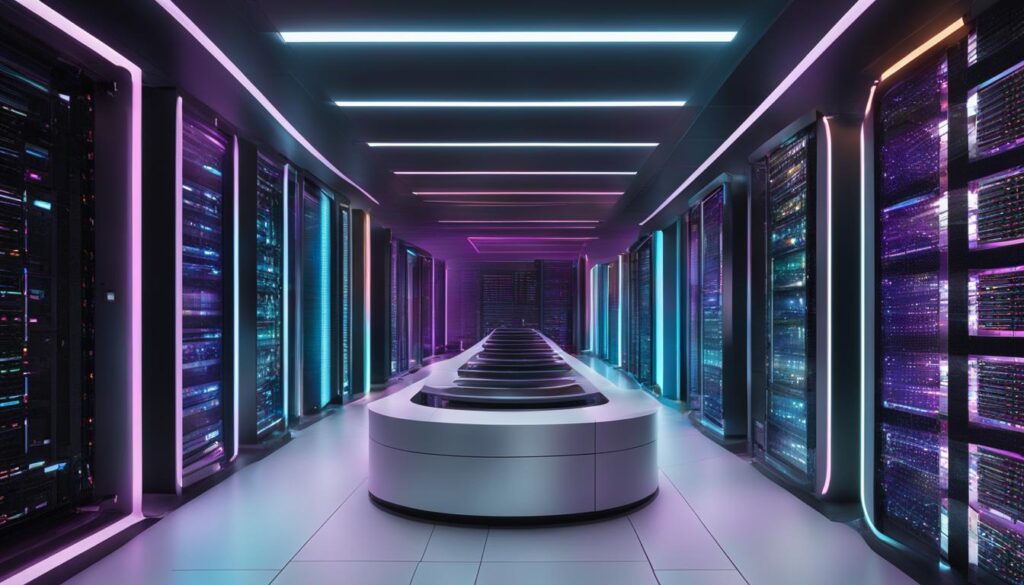
Actuation and Control System
The Actuation and Control system in IoT technology is fundamental to enabling remote control and manipulation of physical devices based on insights derived from data analysis. This system brings automation and efficient utilization to connected devices in various applications and industries.
Actuation in IoT involves executing actions or commands based on the data processed. It enables the physical devices to respond, adapt, and perform tasks based on real-time information. This capability enhances the effectiveness and efficiency of IoT systems.
Control systems are responsible for managing and overseeing the operations of IoT devices. They provide the necessary infrastructure and protocols for device control, monitoring, and communication. Control systems play a vital role in ensuring the seamless integration and coordination of IoT devices within a network.
By integrating actuation and control systems into IoT architectures, organizations can achieve improved productivity, reduced manual intervention, and enhanced safety measures. This level of automation allows for streamlined workflows, optimized resource allocation, and real-time decision-making.
Actuation and control systems facilitate the following:
- Remote control of industrial machinery and equipment
- Environmental control in smart homes and buildings
- Automation of processes in manufacturing and logistics
- Smart agriculture for efficient irrigation and crop management
- Real-time adjustments of energy consumption in smart grids
In summary, the actuation and control system in IoT technology is crucial for achieving automation, efficiency, and seamless integration of physical devices. It enables the remote control and manipulation of devices based on real-time data insights, empowering organizations to optimize their operations and enhance overall productivity.
The Role of Actuation and Control in IoT
The actuation and control system plays a vital role in IoT by:
- Enabling automation: Actuation allows for the automation of tasks and processes in IoT systems, reducing reliance on manual intervention.
- Enhancing decision-making: Control systems provide real-time data and insights, enabling informed decision-making based on current conditions.
- Improving efficiency: By remotely controlling devices, organizations can optimize resource allocation, reduce energy consumption, and improve overall operational efficiency.
- Enabling scalability: Actuation and control systems are scalable, allowing organizations to easily integrate and manage a growing number of IoT devices.
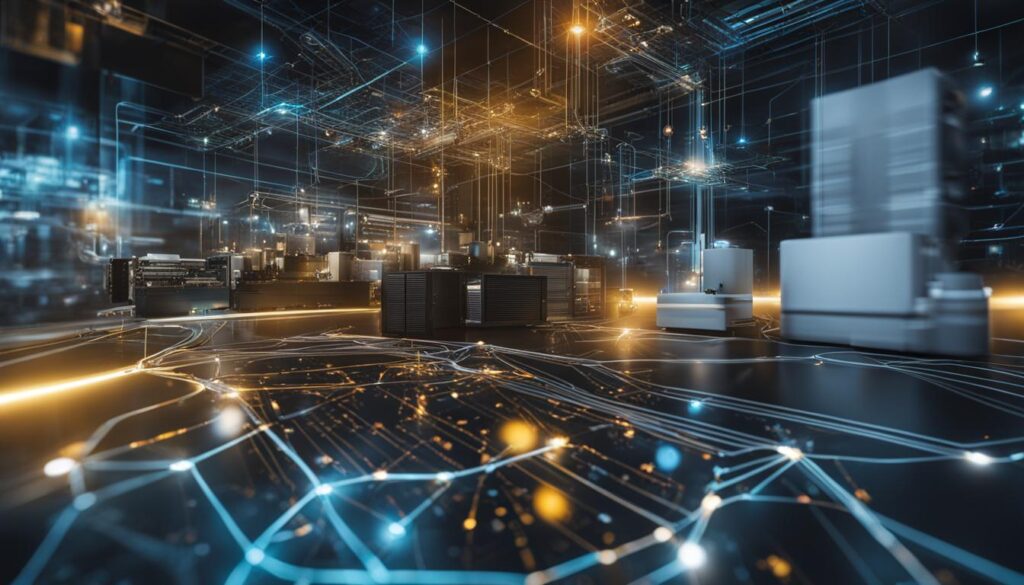
Interplay of the Four Systems in IoT
The functionality and capabilities of IoT technology are made possible through the interplay of four primary systems. These systems work together seamlessly to collect, transmit, process, analyze, and control data, enabling the Internet of Things to thrive.
The first system, the Sensing and Perception system, acts as the eyes and ears of IoT devices. It utilizes sensors to collect data from the physical world. These sensors play a crucial role in converting non-electrical inputs into electrical signals that can be processed.
Once the data is collected, it is transmitted to the second system, the Communication and Connectivity system. This system ensures the seamless transfer of data from the sensors to the cloud or designated processing systems. Various connectivity options such as Wi-Fi, Bluetooth, and cellular networks are employed to ensure reliable data transmission.
The third system, the Data Processing and Analytics system, plays a vital role in transforming the collected data into valuable insights. Through data processing and advanced analytics techniques, this system extracts meaningful information, patterns, and trends from the data. These insights can inform decision-making, optimize processes, and drive innovation.
Finally, the fourth system, the Actuation and Control system, enables the remote control and manipulation of physical devices based on the insights derived from data analysis. This system allows for automated responses and actions to be taken based on the analyzed data, creating a feedback loop between the physical world and the digital realm of IoT.
In the words of Bill Gates, “The advance of technology is based on making it fit in so that you don’t really even notice it, so it’s part of everyday life.” The interplay of the four systems in IoT achieves exactly that, seamlessly integrating technology into our daily lives.
The following table provides a summarized overview of how the four systems work together in IoT:
| Sensing and Perception system | Communication and Connectivity system | Data Processing and Analytics system | Actuation and Control system |
|---|---|---|---|
| Collects data from the physical world | Transmits data from sensors to processing systems | Analyzes data and extracts valuable insights | Enables remote control and manipulation of devices |
| Utilizes sensors to convert non-electrical inputs into electrical signals | Ensures seamless data transfer through connectivity platforms | Transforms data into actionable information | Allows for automated responses based on analyzed data |
| Acts as the “eyes and ears” of IoT devices | Enables reliable data transmission | Unveils patterns, trends, and anomalies in data | Facilitates the efficient control of physical devices |
By understanding the interplay of these four systems, we can unlock the full potential of IoT technology, creating a more connected, automated, and intelligent world.
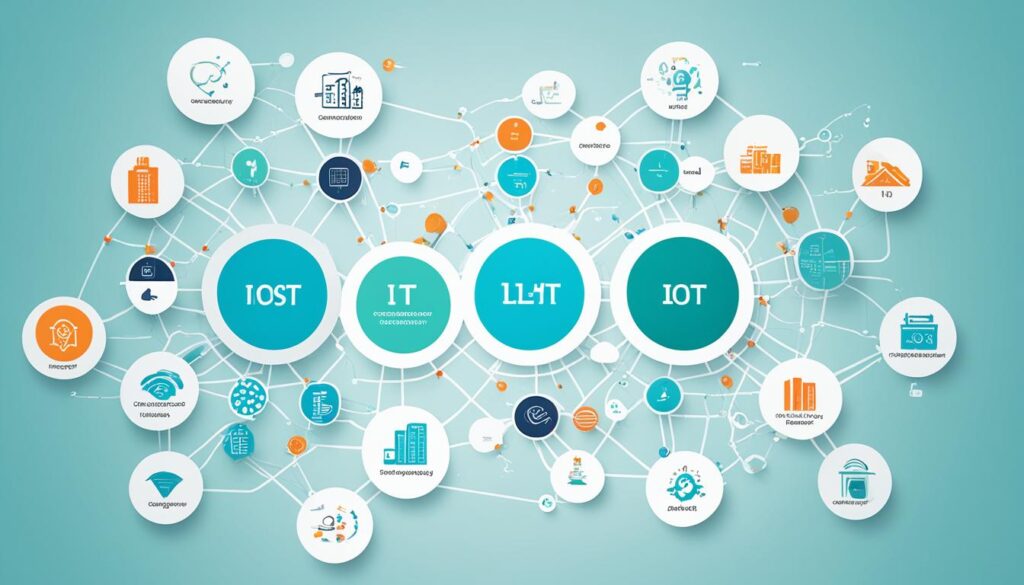
Real-world Examples of IoT Systems
IoT technology has transformed various industries, providing innovative solutions that enhance efficiency and connectivity. Let’s explore some real-world examples of IoT systems that leverage the four primary systems of IoT technology:
1. Smart Homes
Smart homes utilize IoT technology to create a connected and automated living environment. Through the Sensing and Perception system, sensors installed in homes collect data on temperature, lighting, security, and energy consumption. The Communication and Connectivity system enables the seamless transfer of this data to a central hub or smartphone app. Data Processing and Analytics system analyzes the collected information to optimize energy usage, enhance security, and provide personalized experiences for homeowners. With the Actuation and Control system, residents can remotely control various home devices, such as lighting, thermostats, and security systems, using voice commands or mobile apps.
2. Smart Cities
Smart cities leverage IoT systems to improve the quality of life for citizens while enhancing sustainability and efficiency. In a smart city, the Sensing and Perception system involves the deployment of sensors throughout urban areas to collect data on traffic congestion, air quality, waste management, and more. The Communication and Connectivity system enables real-time data transmission to city management systems for analysis and decision-making. Data Processing and Analytics system analyzes the collected data to optimize traffic flow, manage resources effectively, and improve urban planning. The Actuation and Control system allows city authorities to implement smart solutions such as adaptive traffic signals, smart street lighting, and waste management systems, creating a more livable and sustainable environment.
3. Industrial IoT
Industrial IoT (IIoT) revolutionizes manufacturing processes, boosting productivity, efficiency, and safety. In the industrial setting, the Sensing and Perception system monitors machines, equipment, and processes, detecting anomalies, and collecting vital data. The Communication and Connectivity system enables this data to be transmitted to a central control system or cloud-based platforms for real-time monitoring and analysis. Data Processing and Analytics system employs machine learning algorithms to identify patterns, optimize operations, and predict maintenance needs. With the Actuation and Control system, production processes can be remotely monitored and controlled, enabling quick adjustments and automation.
These real-world examples illustrate the power of IoT systems in transforming our everyday lives and driving digital innovation. By harnessing the capabilities of the four primary systems of IoT technology, these systems provide intelligent, automated solutions that improve efficiency, enhance decision-making, and create a more connected environment.
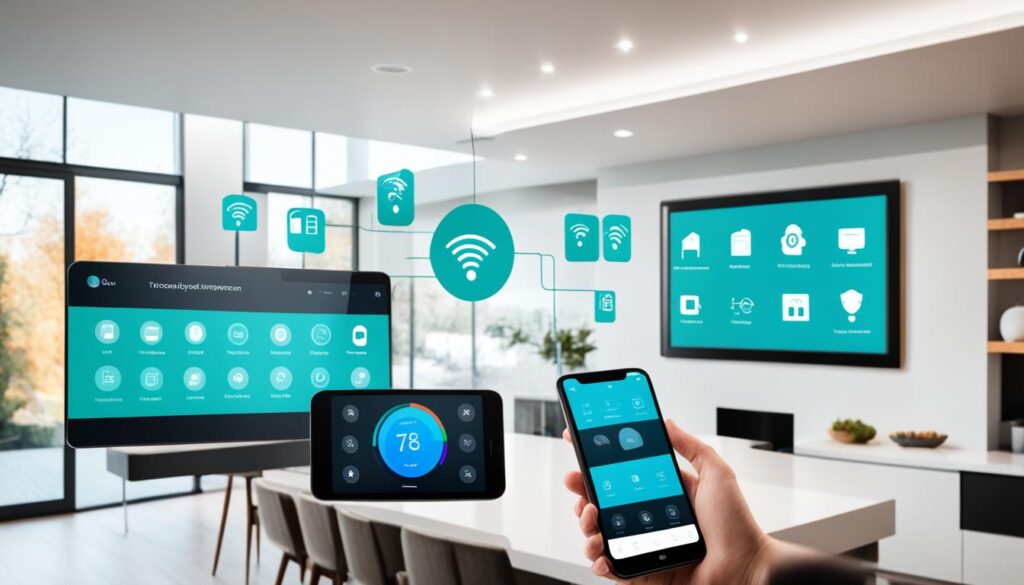
How Does Point-and-Click Technology Connect to the Primary Systems of IoT Technology?
Point-and-click technology is an essential component of IoT systems, as it connects with the primary systems seamlessly. With the pointandclick operating system interface, users can easily navigate and control IoT devices, enabling effortless management and monitoring. This user-friendly interface simplifies the integration of IoT technology into our daily lives, making it accessible to a wider range of individuals.
Conclusion
The future of IoT is filled with tremendous potential, paving the way for further advancements and innovations. As we continue to explore and harness the capabilities of IoT technology, we can anticipate witnessing transformative changes in various industries. The four primary systems of IoT technology – Sensing and Perception, Communication and Connectivity, Data Processing and Analytics, and Actuation and Control – will play a pivotal role in shaping the future of technology and revolutionizing industries on a global scale.
With the Sensing and Perception system, IoT devices can gather data from the physical world, enabling us to gain valuable insights into our environment. The Communication and Connectivity system ensures seamless data transfer, allowing for timely and accurate transmission of information. The Data Processing and Analytics system analyzes the collected data, extracting actionable insights that can drive informed decisions and optimizations. Lastly, the Actuation and Control system empowers us to remotely control and manipulate devices based on data analysis, enabling automation and improving operational efficiency.
Together, these four systems work harmoniously to form a comprehensive IoT ecosystem. As IoT continues to mature and evolve, there is bound to be an increasing integration of smart devices and connected systems, leading to enhanced connectivity and a more intelligent world. The future of IoT holds the promise of smart homes, smart cities, and industrial IoT, where technology enhances our lives, simplifies processes, and improves sustainability. With its limitless potential, the future of IoT is indeed bright and is set to revolutionize how we interact with our surroundings.

